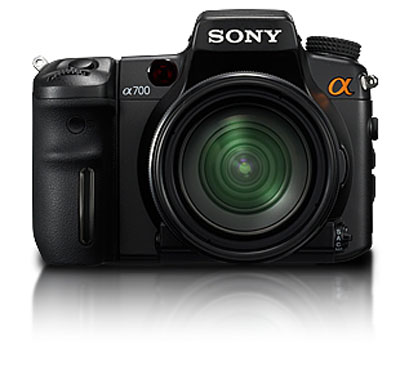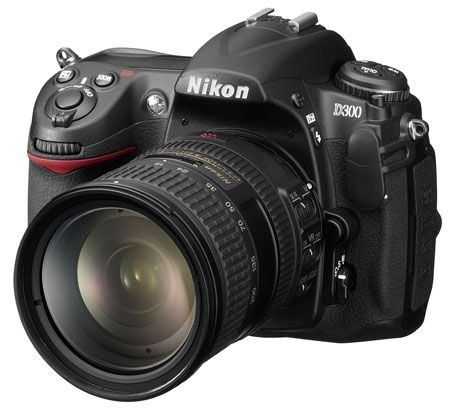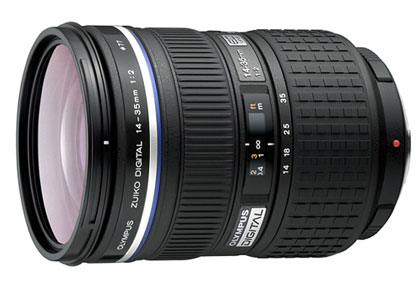Digital Camera Buyers' Guide - Year of the SLR
by Wesley Fink on November 23, 2007 6:00 AM EST- Posted in
- Digital Camera
Prosumer SLRs
It seems everyone is introducing new prosumer models. Understanding what's hot in this market of hard-to-please photography buffs will help you know what to look for in an entry-level camera. If you're in the market for one of these advanced amateur DSLRs, you may want to pay closer attention.

Sony started this prosumer round, just as they started the 10 megapixel (MP) round last year. The new top-of-the-line Sony is now their $1400 A700. Those who doubted that Sony was in the digital SLR market to win were greeted with a slick, stylish, and very fast 12.2MP DSLR with image stabilization, auto dust cleaning, a 3" hi-res LCD, 5.0FPS shooting, and new Sony brand lenses. Conspicuously absent is Live View, a feature pioneered by Olympus on DSLR cameras that allows the user to see through the lens on the LCD. This is standard fare on a point-and-shoot, but difficult to do with the "through-the-lens" optical viewing that is a feature of SLR technology.

Because they are so huge and influential in the photo market, Canon prosumer models receive lots of scrutiny. The new Canon model is the 40D, which continues the 20D/30D models that have defined the Canon prosumer DSLR. The 30D is 8MP and the 40D raises that to 10MP. Many expected an even higher-resolution 40D, but instead the 40D features the same 10MP resolution seen in the entry-level Canon XTi for the past year. New for the $1300 40D is much faster auto-focus, a 3" LCD replacing the 2.5", dust cleaning on startup, dust sealing, and Live View - a first for Canon. There are many other improvements, but they refine existing features of the Canon line.

Nikon announced - but has not shipped - the new D300, which is an update to the D200. The D200 got lost in the wake of the entry-level D80 last year. Nikon uses Sony sensors with their own electronics, and it appears the new D300 uses the same Sony 12.2MP CMOS sensor with on-sensor noise reduction found in the Sony A700. The D300 will launch at a street price of about $1800. The D300 also features a 3" hi-res LCD, very fast autofocus, Nikon's first auto sensor-cleaning system, 6FPS shooting, dust/splash sealing, and Live View.

Olympus has come to life recently, just when many had all but given up on them. Always the innovator, Olympus pioneered auto dust cleaning and Live View on digital SLR cameras based on their "digital-only" 4/3 standard. However, the Olympus 4/3 system was getting very long in the tooth, with a 5.5MP pro model E-1 introduced in 2003. Olympus has just started shipping their new E-3 flagship, which thoroughly updates the Olympus system.
Olympus says the E-3 is their pro model, and it features dust and splash sealing for both the E-3 body and pro lenses. The E-3 also introduces the first new AF module for Olympus in many years. The new AF, which was long overdue, features 11 cross-type sensors, each on two planes, for a total of 44 segments. According to Olympus, the result is the fastest auto focusing SLR you can buy when used with their new SWD (Sonic Wave Drive) lenses, such as their new 12-60mm f2.8-4.0 (24mm-120mm equivalent). The street price of $1699 is much less expensive that the $5000+ entry price for Nikon and Canon pro models. Many, however, feel the real competition for the E-3 is the "prosumer" Nikon D300 and Canon 40D.
The E-3 is also the first Olympus pro model to feature built-in flash, and it's dust and splash sealed. Auto sensor cleaning is a feature, image stabilization is built in and works with all lenses, and the latest incarnation of Live View with a fold out articulating LCD screen is featured. The LCD screen is 2.5", and not the 3" screen of competing models, but competing models don't have a flip-out LCD. Resolution is 10MP, but the E-3 supports ISO-3200 and it is definitely the low-noise camera many didn't think was possible with the smaller 4/3 sensor.
Canon ditched their FD breech mount years ago when they first introduced the EOS autofocus system. That risky move has paid off handsomely for Canon with their current line of all electronic, lens-motor driven lenses. Olympus took a similar tact by ditching their OM mount for an all-electronic mount for digital cameras. However, Olympus didn't have the influence of a Canon when they championed a smaller 4/3 standard sensor and claimed that lenses needed different designs for best digital performance. This was regarded by most of us as marketing-speak, but recent reviews of Olympus glass are showing their 4/3 lens designs - even their cheap kit lenses - do have less light fall-off and are generally sharper in digital photography than competing systems using APS-C or 35mm lenses.

The bottom line is the E-3 and recent Olympus lenses like the pro 14-35 f2.0 zoom (equivalent 28-70mm) and the tiny, cheap, but excellent quality 40-150mm (equivalent 80-300) f4.0-5.6 kit lens may finally gain Olympus the respect in the digital SLR market that has eluded them up to now.










74 Comments
View All Comments
Johnmcl7 - Saturday, November 24, 2007 - link
The Digilux 3 is the Leica branded version of the Panasonic DMC-L1 and they're both relatively hefty cameras when compared to the smaller E-410/E-510 cameras or even their Olympus sibling the E-330. Although not anywhere near as big as something like the 5D, the Digilux 3 is bigger than the E-510.The Digilux 2 was a smaller camera (Leica version of the Panasonic LC-1) which may be the one you're thinking of although this wasn't an SLR despite the similarity in design to the L1/Digilux 3.
Also, the E-3 doesn't have a lens cleaning feature:
"The E-3 is also the first Olympus pro model to feature built-in flash, and it's dust and splash sealed. Auto lens cleaning is a feature, image stabilization is built in and works with all lenses, and the latest incarnation of Live View with a fold out articulating LCD screen is featured."
I assume you're referring to the sensor cleaning feature?
John
Johnmcl7 - Saturday, November 24, 2007 - link
The Digilux 3 is the Leica branded version of the Panasonic DMC-L1 and they're both relatively hefty cameras when compared to the smaller E-410/E-510 cameras or even their Olympus sibling the E-330. Although not anywhere near as big as something like the 5D, the Digilux 3 is bigger than the E-510.The Digilux 2 was a smaller camera (Leica version of the Panasonic LC-1) which may be the one you're thinking of although this wasn't an SLR despite the similarity in design to the L1/Digilux 3
John
Johnmcl7 - Saturday, November 24, 2007 - link
The Digilux 3 is the Leica branded version of the Panasonic DMC-L1 and they're both relatively hefty cameras when compared to the smaller E-410/E-510 cameras or even their Olympus sibling the E-330. Although not anywhere near as big as something like the 5D, the Digilux 3 is bigger than the E-510.The Digilux 2 was a smaller camera (Leica version of the Panasonic LC-1) which may be the one you're thinking of although this wasn't an SLR despite the similarity in design to the L1/Digilux 3
John
Johnmcl7 - Saturday, November 24, 2007 - link
The Digilux 3 is the Leica branded version of the Panasonic DMC-L1 and they're both relatively hefty cameras when compared to the smaller E-410/E-510 cameras or even their Olympus sibling the E-330. Although not anywhere near as big as something like the 5D, the Digilux 3 is bigger than the E-510.The Digilux 2 was a smaller camera (Leica version of the Panasonic LC-1) which may be the one you're thinking of although this wasn't an SLR despite the similarity in design to the L1/Digilux 3
John
Johnmcl7 - Saturday, November 24, 2007 - link
The Digilux 3 is the Leica branded version of the Panasonic DMC-L1 and they're both relatively hefty cameras when compared to the smaller E-410/E-510 cameras or even their Olympus sibling the E-330. Although not anywhere near as big as something like the 5D, the Digilux 3 is bigger than the E-510.The Digilux 2 was a smaller camera (Leica version of the Panasonic LC-1) which may be the one you're thinking of although this wasn't an SLR despite the similarity in design to the L1/Digilux 3
John
Johnmcl7 - Saturday, November 24, 2007 - link
The Digilux 3 is the Leica branded version of the Panasonic DMC-L1 and they're both relatively hefty cameras when compared to the smaller E-410/E-510 cameras or even their Olympus sibling the E-330. Although not anywhere near as big as something like the 5D, the Digilux 3 is bigger than the E-510.The Digilux 2 was a smaller camera (Leica version of the Panasonic LC-1) which may be the one you're thinking of although this wasn't an SLR despite the similarity in design to the L1/Digilux 3
John
Johnmcl7 - Saturday, November 24, 2007 - link
The Digilux 3 is the Leica branded version of the Panasonic DMC-L1 and they're both relatively hefty cameras when compared to the smaller E-410/E-510 cameras or even their Olympus sibling the E-330. Although not anywhere near as big as something like the 5D, the Digilux 3 is bigger than the E-510.The Digilux 2 was a smaller camera (Leica version of the Panasonic LC-1) which may be the one you're thinking of although this wasn't an SLR despite the similarity in design to the L1/Digilux 3
John
Johnmcl7 - Saturday, November 24, 2007 - link
The Digilux 3 is the Leica branded version of the Panasonic DMC-L1 and they're both relatively hefty cameras when compared to the smaller E-410/E-510 cameras or even their Olympus sibling the E-330. Although not anywhere near as big as something like the 5D, the Digilux 3 is bigger than the E-510.The Digilux 2 was a smaller camera (Leica version of the Panasonic LC-1) which may be the one you're thinking of although this wasn't an SLR despite the similarity in design to the L1/Digilux 3
John
smmorrison - Saturday, November 24, 2007 - link
This isn't a bad buying guide and certainly better than wired magazines recent guide which was horrible.My main concern(and I am a photography teacher) is that these guides don't ever really take into account one of the primary reasons for buying a DSLR...the lenses & accessories. There are many reasons why most pros or semi pros choose nikon or canon(and I am a canon guy myself). They have lenses and accessories for everything. Need a macro lens, got it, need a tilt shift...got it...super tele for birdwatching or sports...got it...super low light prime...got it. And I think sports will be a main reason for many families buying DSLR's. Nikon and Canon are far superior for shooting sports. There are 3rd party alternatives for many other brands, but they often are not as good as the manufacturers lenses or have issues with focusing or compatibility(sigma is well known for this). Then there are the accessories...off camera flashes, macro flashes, off camera cords, battery grips...the list goes on. Some of the other brands might have some of these as well...but at some point, if a photographer progresses they will likely reach a point where sony or olympus or even pentax doesnt have the lens or accessory for what they want to do. Might not happen, but if you get really into the hobby it probably will. There is also the factor of the used lens market...It is far easier to find used lenses for Nikon and Canon on ebay, FredMiranda, B&H, etc.
I also fully agree with some of the above comments about image quality. These are DSLR's NOT point and shoots...I think people have gotten obsessed with features with point and shoot cameras, but with DSLR's its about the image quality...and what these articles frequently forget is that the image quality often comes down to the glass. You are really buying a lens system, not a body...Megapixels, in camera stabilization, and sensor cleaning really are not that big a deal.
The only '3nd tier' brand that would be interesting is Pentax, since you can use their older lenses...a big factor, since many of the older primes are great lenses and can be bought cheap. I would never recommend Sony or Olympus to students or friends.
If magazines and websites are going to start talking about DSLR's, they need to not focus on the bodies so much and start seriously talking about the lenses and recognize that Canon and Nikon are on top for a reason...they have everything you will ever need for your camera.
just my .02
Wesley Fink - Saturday, November 24, 2007 - link
Actually we chose the Olympus E-510 2-lens kit BECAUSE of the superior imaging quality of the kit lenses. Both kit lenses, which cover the 35mm equivalent of 28mm to 300 mm are far better in image quality than either Canon or Nikon kit lenses. Check out other review sites and you will see many other sites agree the Olympus kit lenses are better quality than the competition and that Olympus 4/3 lenses in general provide better image quality than competing lenses on APS-C cameries.Do we ignore image quality and select Canon or Nikon because they are better known in DSLR? We agree and stated that Canon or Nikon are the safe choices, but thy are not necessarily the best quality in digital imaging.